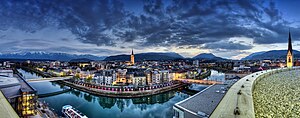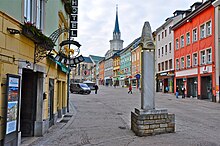Villach
Villach | ||
|---|---|---|
 Drava riverside | ||
|
Postal code 9500 | ||
| Area code | 04242 | |
| Vehicle registration | VI | |
| Website | villach.at | |
Villach (German pronunciation:
Together with other Alpine towns Villach engages in the Alpine Town of the Year Association for the implementation of the Alpine Convention to achieve sustainable development in the Alpine Arc. In 1997, Villach was the first town to be awarded Alpine Town of the Year.
Geography

Villach is a
The Villach city limits comprise the following districts and villages:
|
|
In 1905 a part of the municipal area St. Martin was incorporated. In 1973 the city area was further enlarged through the incorporation of Landskron, Maria Gail and Fellach.
Climate
Villach has a cool summer humid continental climate (Köppen Dfb).
| Climate data for Villach 1971-2000 | |||||||||||||
|---|---|---|---|---|---|---|---|---|---|---|---|---|---|
| Month | Jan | Feb | Mar | Apr | May | Jun | Jul | Aug | Sep | Oct | Nov | Dec | Year |
| Mean daily maximum °C (°F) | 1.4 (34.5) |
5.2 (41.4) |
10.6 (51.1) |
14.9 (58.8) |
20.2 (68.4) |
23.4 (74.1) |
25.6 (78.1) |
25.2 (77.4) |
20.8 (69.4) |
14.5 (58.1) |
6.6 (43.9) |
1.8 (35.2) |
14.2 (57.6) |
| Daily mean °C (°F) | −3.2 (26.2) |
−0.6 (30.9) |
4.0 (39.2) |
8.3 (46.9) |
13.5 (56.3) |
16.7 (62.1) |
18.7 (65.7) |
18.3 (64.9) |
14.1 (57.4) |
8.5 (47.3) |
2.2 (36.0) |
−2.1 (28.2) |
8.2 (46.8) |
| Mean daily minimum °C (°F) | −6.4 (20.5) |
−4.6 (23.7) |
−0.8 (30.6) |
3.1 (37.6) |
7.9 (46.2) |
11.1 (52.0) |
12.9 (55.2) |
12.8 (55.0) |
9.2 (48.6) |
4.6 (40.3) |
−0.7 (30.7) |
−4.8 (23.4) |
3.7 (38.7) |
| Average precipitation mm (inches) | 46.8 (1.84) |
47.1 (1.85) |
65.5 (2.58) |
83.2 (3.28) |
96.1 (3.78) |
120.5 (4.74) |
133.7 (5.26) |
111.3 (4.38) |
102.3 (4.03) |
105.5 (4.15) |
102.2 (4.02) |
61.2 (2.41) |
1,075.4 (42.34) |
| Average precipitation days (≥ 1.0 mm) | 5.9 | 5.3 | 7.1 | 9.0 | 10.4 | 12.0 | 11.9 | 10.1 | 8.2 | 8.3 | 7.7 | 6.3 | 102.2 |
| Mean monthly sunshine hours | 84.4 | 120.3 | 160.6 | 167.7 | 208.4 | 214.3 | 245.2 | 227.2 | 190.3 | 142.0 | 85.9 | 73.2 | 1,919.5 |
| Source: Zamg.ac.at[4] | |||||||||||||
History

The oldest human traces found in Villach date back to the late
When about 740 Prince

Villach received
From 1526 onwards, many citizens turned
During the
The town obtained
During
Population
| Year | Pop. | ±% |
|---|---|---|
| 1910 | 27,451 | — |
| 1923 | 30,883 | +12.5% |
| 1934 | 34,085 | +10.4% |
| 1939 | 36,012 | +5.7% |
| 1951 | 43,358 | +20.4% |
| 1961 | 47,170 | +8.8% |
| 1971 | 51,112 | +8.4% |
| 1981 | 52,692 | +3.1% |
| 1991 | 54,640 | +3.7% |
| 2001 | 57,497 | +5.2% |
| 2011 | 59,285 | +3.1% |
| 2016 | 61,221 | +3.3% |
Politics

Municipal council
The municipal council (Gemeinderat) consists of 45 members, with the mayor as president, and following the 2015 elections:[8]
- Social Democratic Party of Austria (SPÖ): 23 seats
- Austrian People's Party (ÖVP): 10 seats
- Freedom Party of Austria (FPÖ): 7 seats
- Austrian Green Party: 3 seats
- Verantwortung Erde: 1 seat
- NEOS: 1 seat
City government
The city government of Villach (Stadtsenat) consists of seven members. It is chaired by the mayor, who is directly elected by the people. The other members—two vice-mayors and four town councillors—are appointed by the municipal council, with party affiliations according to the election results.
- Mayor Günther Albel, SPÖ
- First vice-mayor Mag. Dr. Petra Oberrauner, SPÖ
- Second vice-mayor Mag. Gerda Sandriesser, SPÖ
- Councillor Mag. Peter F. Weidinger, ÖVP
- Councillor Erwin Baumann, FPÖ
- Councillor Mag. Harald Sobe, SPÖ
- Councillor Katharina Spanring, ÖVP
In the March 2015 elections, Günther Albel was elected with 55.46 per cent of the votes cast.[9]
| Nationality | Population (2013) |
|---|---|
| 1,549 | |
| 1,421 | |
| 1,238 | |
| 482 | |
| 459 | |
| 364 |
Twin towns—sister cities
Villach is
Festivals
There are several festivals throughout the year:
- The carnival in Villach (which starts on November 11 and ends on March 4)
- The arts and crafts festival (with self made goods)
- Villacher Fasching or Mardi Gras
- The streets-art festival (displays performances of artists and singers)
- The "Villacher Kirchtag" (a festival spanning a whole week in summer and ends on August's first Saturday.)
- Performances on a floating stage on the Drau River
Notable citizens




- Ludwig Willroider (1845 – 1910), an Austrian landscape painter and etcher.
- Governor of Bosnia and Herzegovina in Sarajevo from 1911 to 1914, when Archduke Franz Ferdinand of Austriawas assassinated there
- pathologist viz Ghon focus and Ghon's complex
- Oskar Kraus, (DE Wiki) (1887-1973 in Villach), Mayor of Villach 1938-1945
- Hans Kurath (1891 in Villach – 1992) American linguist, emigrated to the US in 1907
- Carl-Heinz Birnbacher (1910 in Villach – 1991) German naval officer, Vice admiral of the German Navy
- Albert Bach (1910 in Treffen – 2003) soldier, Generalmajor, and skier, competed at the 1936 Winter Olympics.
- Heidemarie Hatheyer (1918 in Villach – 1990) film actress, appearing in 43 films between 1938 and 1988
- Paul Watzlawick (1921 in Villach – 2007) Austrian-American therapist, psychologist and communications theorist.
- Kurt Diemberger (born 1932), author and mountaineer
- Bruno Gironcoli (1936 in Villach – 2010) Austrian modern artist
- Heidelinde Weis (1940 – 2023) Austrian actress
- CEO of the Nestlé Group and of Formula One Group
- George Zebrowski (born 1945 in Villach) American science fiction author and editor
- Zoltan J. Acs (born 1947 in Villach) American economist and Professor of Management at The LSE
- Felix Tretter (born 1949 in Villach) Austrian psychologist, psychiatrist and cybernetician
- Werner Kofler (1947 in Villach – 2011) Austrian postmodernism novelist
- Konrad Paul Liessmann (born 1953), philosopher, essayist and cultural publicist.
- Gerald Kargl (born 1953 in Villach) Austrian film director, directed the 1983 film Angst
- non-attached MEP
- Gernot Rumpold (born 1957 in Villach) Austrian politician, associate of Jörg Haider
- Merck & Co now CEO of Siemenssince 2007
- Michael Martin Kofler (born 1966), classical flautist with the Munich Philharmonic
- Austrian Green Party
- Alexander Kaimbacher (born 1969), Austrian operatic tenor
- Thomas Smolej (1982 in Villach) Austrian actor and director
- Florian Hufsky (1986 in Villach – 2009) Austrian new media artist, board member of the Pirate Party of Austria
Sport
- Hanns Brandstätter (born 1949 in Villach) fencer; competed in at the 72, 76, and 1984 Summer Olympics
- Alex Antonitsch (born 1966 in Villach) former tennis player from Austria, turned professional in 1988
- Christian Mayer (born 1972), former alpine skier, twice bronze medallist in the 1994 & 1998 Winter Olympics
- Bärbel Jungmeier (born 1975 in Villach) road cyclist and mountain bike rider, rode at the 2004 Summer Olympics
- Gerhard Unterluggauer (born 1976 in Villach) Austrian former professional ice hockey defenceman
- Roland Kollmann (born 1976 in Villach) retired footballer for Grazer AK, played 343 games and 11 for Austria
- biathletetwice Olympic team medallist
- Jürgen Pichorner (born 1977), an Austrian football midfielder who has played over 330 games
- biathlete
- Martin Koch (born 1982 in Villach) former ski jumper, team gold medallist at the 2006 Winter Olympics
- Michael Grabner, (born 1987 in Villach) Austrian professional ice hockey player for New York Rangers of the NHL
- Marc Sand (born 1988 in Rosegg) Austrian footballer, who plays for SK Austria Klagenfurt
- Michael Raffl (born 1988 in Villach) professional ice hockey left winger for Dallas Stars of the NHL
- Rapid Wien, has played 26 games for Austria
- Christopher Wernitznig (born 1990), an Austrian footballer who has played over 470 games
- Anna Gasser (born 1991 in Villach) snowboarder, two-time Olympic gold medalist in Big Air (2018 and 2022)
- Marco Schwarz (born 1995 in Villach) Austrian World Cup alpine ski racer
- Christopher Höher (born 1997 in Villach) Austrian racing driver
- Daniela Ulbing (born 1998), an Austrian snowboarder, silver medallist at the 2022 Winter Olympics
References
- ^ "Dauersiedlungsraum der Gemeinden Politischen Bezirke und Bundesländer - Gebietsstand 1.1.2018". Statistics Austria. Retrieved 10 March 2019.
- ^ "Einwohnerzahl 1.1.2018 nach Gemeinden mit Status, Gebietsstand 1.1.2018". Statistics Austria. Retrieved 9 March 2019.
- ^ "Einwohnerzahl und Komponenten der Bevölkerungsentwicklung (Population and Components of Population Growth)" (PDF) (in German). Statistik Österreich (English Version). 2007-11-29. Retrieved 2007-12-27.
- ^ "Klimadaten von Österreich 1971 - 2000".
- ISBN 3-85435-501-7
- ^ ORF Kärnten, "Oskar Kraus - ein korrekter Nazi"[permanent dead link] (in German)
- ^ "Luftkrieg (aerial warfare) "Ostmark"". airpower.at (in German). Martin Rosenkranz. 2003-08-13. Retrieved 2007-12-18.
- ^ Wahlstatistiken – Stadt Villach
- ^ Wahlergebnisse 2015 Archived 2017-02-02 at the Wayback Machine
- ^ "Statistisches Jahrbuch 2014". www.villach.at. Stadt Villach - Melde- und Standesamt, Statistik. Retrieved 2015-09-03.
External links
- "Municipal data for Villach". Statistik Austria.
- Villach - Official website (English version)
- Kowatsch - Villach Bus System official site
- Official website of the Carinthia University of Applied Sciences - FH Kärnten
